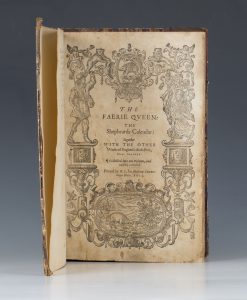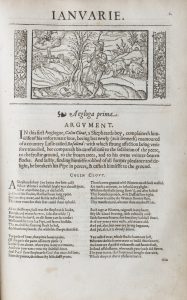
I have long admired the work of the Elizabethan writer Edmund Spenser (1552/53 -1599) so I was delighted to see an early collection of his work, published in 1611, in Toovey’s last specialist sale of Antiquarian and Collectors’ books. . The single volume included ‘The Faerie Queen, ‘The Shepheards Calendar’ and other works.
Edmund Spenser attended Pembroke College, Cambridge from 1569. He studied the Classics in Latin and Greek as well as Italian and English literature. He was awarded a Bachelor of Arts degree in 1573 and a Master of Arts degree in 1576.
Spenser’s ‘The Shepheards Calendar’ published in 1579/1580 is often described as being the first work in the 16th century English literary Renaissance and is influenced by the Roman poet Virgil’s pastoral Bucolics.
‘The Shepheards Calendar’ is formed of twelve short poems each named after a month in the year and is beautifully illustrated with woodblock vignettes. The elegantly constructed verse gives expression to a series of conversations between simple shepherds. Paradoxically these conversations form satirical, sophisticated commentaries on the questions and ambitions of the day.

For example ‘Aprill’ speaks in praise of the shepherdess Elisa who Spenser uses to represent Elizabeth I. Edmund Spenser was a protestant and supporter of Elizabeth I. He gave voice to the importance of upholding and protecting the national and moral purity of the Elizabethan church. The good and bad shepherds act as metaphors for reformed and catholic clergy respectively.
Spenser’s poem ‘The Faerie Queene’ is considered to be one of the greatest in the English language. It is an allegorical work in praise of Elizabeth I who is represented by the Faerie Queene, Gloriana. The poem provides a celebration and critique of the Tudor dynasty employing frequent allusions to contemporary Elizabethan politics and events.
This epic poem is written in an archaic style and takes the form of a series of books. Each book follows the adventures of a particular knight who in turn represent the virtues of holiness, temperance, chastity, friendship, justice and courtesy. The first part was published in 1590 but Spenser never completed it.
Edmund Spenser’s work brings together the influences of the Elizabethan age he inhabited, his strong Christian faith, early myth, legends and folklore which resonate with literary enthusiasts today. This volume, in its later binding, realised £2400.
Toovey’s book specialists Charlie Howe and Nick Toovey are currently preparing their next specialist auction of books which will be held on Tuesday 13th August. Whether you are seeking to sell your books or building a collection they are always delighted to offer advice and share their passion for their subject with others. You can contact them by telephoning 01903 891955.
By Rupert Toovey, a senior director of Toovey’s, the leading fine art auction house in West Sussex, based on the A24 at Washington. Originally published in the West Sussex Gazette.